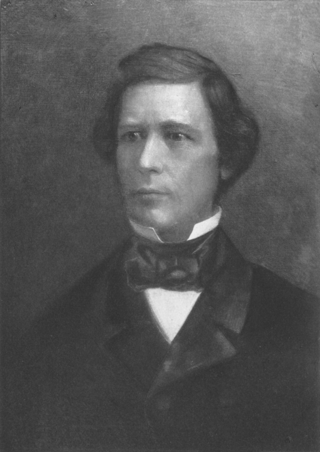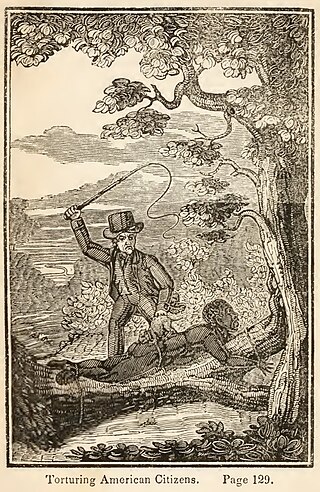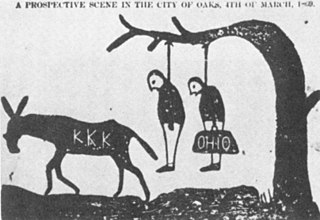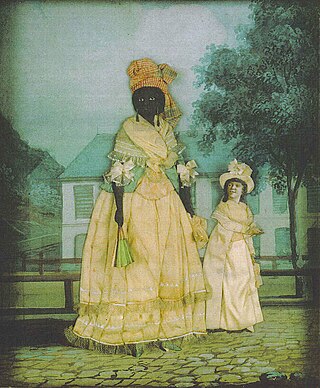Related Research Articles

The American Civil War was a civil war in the United States between the Union and the Confederacy, which had been formed by states that had seceded from the Union.

The Compromise of 1850 was a package of five separate bills passed by the United States Congress in September 1850 that temporarily defused tensions between slave and free states in the years leading up to the American Civil War. Designed by Whig senator Henry Clay and Democratic senator Stephen A. Douglas, with the support of President Millard Fillmore, the compromise centered on how to handle slavery in recently acquired territories from the Mexican–American War (1846–48).

The Wilmot Proviso was an unsuccessful 1846 proposal in the United States Congress to ban slavery in territory acquired from Mexico in the Mexican–American War. The conflict over the Wilmot Proviso was one of the major events leading to the American Civil War.

The legal institution of human chattel slavery, comprising the enslavement primarily of Africans and African Americans, was prevalent in the United States of America from its founding in 1776 until 1865, predominantly in the South. Slavery was established throughout European colonization in the Americas. From 1526, during the early colonial period, it was practiced in what became Britain's colonies, including the Thirteen Colonies that formed the United States. Under the law, an enslaved person was treated as property that could be bought, sold, or given away. Slavery lasted in about half of U.S. states until abolition in 1865, and issues concerning slavery seeped into every aspect of national politics, economics, and social custom. In the decades after the end of Reconstruction in 1877, many of slavery's economic and social functions were continued through segregation, sharecropping, and convict leasing.

In United States history, the pejorative scalawag referred to white Southerners who supported Reconstruction policies and efforts after the conclusion of the American Civil War.

A consensus of historians who address the origins of the American Civil War agree that the preservation of the institution of slavery was the principal aim of the eleven Southern states that declared their secession from the United States and united to form the Confederate States of America. However, while historians in the 21st century agree on the centrality of slavery in the conflict, they disagree sharply on which aspects of this conflict were most important, and on the North's reasons for refusing to allow the Southern states to secede. Proponents of the pseudo-historical Lost Cause ideology have denied that slavery was the principal cause of the secession, a view that has been disproven by the overwhelming historical evidence against it, notably the seceding states' own secession documents.

The history of the United States from 1849 to 1865 was dominated by the tensions that led to the American Civil War between North and South, and the bloody fighting in 1861-1865 that produced Northern victory in the war and ended slavery. At the same time industrialization and the transportation revolution changed the economics of the Northern United States and the Western United States. Heavy immigration from Western Europe shifted the center of population further to the North.

The history of the Southern United States spans back thousands of years to the first evidence of human occupation. The Paleo-Indians were the first peoples to inhabit the Americas and what would become the Southern United States. By the time Europeans arrived in the 15th century, the region was inhabited by the Mississippian people, well known for their mound-building cultures, building some of the largest cities of the Pre-Columbian United States. European history in the region would begin with the earliest days of the exploration. Spain, France, and especially England explored and claimed parts of the region.
In American history, the Fire-Eaters were a group of pro-slavery Democrats in the antebellum South who urged the separation of Southern states into a new nation, which became the Confederate States of America. The dean of the group was Robert Rhett of South Carolina. Some sought to revive America's participation in the Atlantic slave trade, which had been illegal since 1808.

The Lost Cause of the Confederacy is an American pseudohistorical and historical negationist myth that claims the cause of the Confederate States during the American Civil War was just, heroic, and not centered on slavery. First enunciated in 1866, it has continued to influence racism, gender roles, and religious attitudes in the Southern United States into the 21st century. Historians have dismantled many parts of the Lost Cause mythos.

In the British colonies in North America and in the United States before the abolition of slavery in 1865, free Negro or free Black described the legal status of African Americans who were not enslaved. The term was applied both to formerly enslaved people (freedmen) and to those who had been born free, whether of African or mixed descent.

The Antebellum South era was a period in the history of the Southern United States that extended from the conclusion of the War of 1812 to the start of the American Civil War in 1861. This era was marked by the prevalent practice of slavery and the associated societal norms it cultivated. Over the course of this period, Southern leaders underwent a transformation in their perspective on slavery. Initially regarded as an awkward and temporary institution, it gradually evolved into a defended concept, with proponents arguing for its positive merits, while simultaneously vehemently opposing the burgeoning abolitionist movement.
Ulrich Bonnell Phillips was an American historian who largely defined the field of the social and economic studies of the history of the Antebellum South and slavery in the U.S. Phillips concentrated on the large plantations that dominated the Southern economy, and he did not investigate the numerous small farmers who held few slaves. He concluded that plantation slavery produced great wealth, but was a dead end, economically, that left the South bypassed by the industrial revolution underway in the North.

The Slave Power, or Slavocracy, referred to the perceived political power held by American slaveowners in the federal government of the United States during the Antebellum period. Antislavery campaigners charged that this small group of wealthy slaveholders had seized political control of their states and were trying to take over the federal government illegitimately to expand and protect slavery. The claim was later used by the Republican Party that formed in 1854–55 to oppose the expansion of slavery.
Plain Folk of the Old South is a 1949 book by Vanderbilt University historian Frank Lawrence Owsley, one of the Southern Agrarians. In it he used statistical data to analyze the makeup of Southern society, contending that yeoman farmers made up a larger middle class than was generally thought.

The Missouri Compromise was a federal legislation of the United States that balanced desires of northern states to prevent the expansion of slavery in the country with those of southern states to expand it. It admitted Missouri as a slave state and Maine as a free state and declared a policy of prohibiting slavery in the remaining Louisiana Purchase lands north of the 36°30′ parallel. The 16th United States Congress passed the legislation on March 3, 1820, and President James Monroe signed it on March 6, 1820.
Historiography examines how the past has been viewed or interpreted. Historiographic issues about the American Civil War include the name of the war, the origins or causes of the war, and President Abraham Lincoln's views and goals regarding slavery.

The presidency of James Buchanan began on March 4, 1857, when James Buchanan was inaugurated as 15th president of the United States, and ended on March 4, 1861. Buchanan, a Democrat from Pennsylvania, took office as the 15th United States president after defeating former President Millard Fillmore of the American Party, and John C. Frémont of the Republican Party in the 1856 presidential election.
The Northern Democratic Party was a leg of the Democratic Party during the 1860 presidential election, when the party split in two factions because of disagreements over slavery. They held two conventions before the election, in Charleston and Baltimore, where they established their platform. Democratic Candidate Stephen A. Douglas was the nominee and lost to Republican Candidate Abraham Lincoln, whose victory prompted the secession of 11 Southern states and the formation of the Confederate States of America.

Slavery as a positive good in the United States was the prevailing view of Southern politicians and intellectuals just before the American Civil War, as opposed to seeing it as a crime against humanity or a necessary evil. They defended the legal enslavement of people for their labor as a benevolent, paternalistic institution with social and economic benefits, an important bulwark of civilization, and a divine institution similar or superior to the free labor in the North.
References
- ↑ Michael Keating, "The end of union? Scottish nationalism and the UK state." in After the Nation? Critical Reflections on Nationalism and Postnationalism (Palgrave Macmillan UK, 2010). 103-119. online
- ↑ Charles S. Sydnor, The Development of Southern Sectionalism 1819–1848 (2008)
- ↑ Robert Royal Russel, Economic Aspects of Southern Sectionalism, 1840–1861 (1973)
- ↑ Adam Rothman, Slave Country: American Expansion and the Origins of the Deep South. (2005)
- ↑ Kenneth M. Stampp, The Imperiled Union: Essays on the Background of the Civil War (1981) p 198; Woodworth, ed. The American Civil War: A Handbook of Literature and Research (1996), 145 151 505 512 554 557 684; Richard Hofstadter, The Progressive Historians: Turner, Beard, Parrington (1969).
- ↑ Clement Eaton, Freedom of Thought in the Old South (1940)
- ↑ John Hope Franklin, The Militant South 1800–1861 (1956)
- ↑ Eric Foner, Free Soil, Free Labor, Free Men: The Ideology of the Republican Party before the Civil War (1969) pp. 40–72.
- ↑ Sydney E. Ahlstrom, A Religious History of the American People (1972) pp 648–69
- ↑ James McPherson, "Antebellum Southern Exceptionalism: A New Look at an Old Question", Civil War History 29 (September 1983).
- ↑ Britannica, The Editors of Encyclopaedia. "sectionalism". Encyclopedia Britannica, 7 Dec. 2020, https://www.britannica.com/topic/sectionalism. Accessed 2 February 2024.
- ↑ Luis Moreno, Ana Arriba, and Araceli Serrano, "Multiple identities in decentralized Spain: The case of Catalonia." Regional & Federal Studies 8.3 (1998): 65-88. online
- ↑ Garth Stevenson, "Canadian Regionalism in Continental Perspective." Journal of Canadian Studies 15.2 (1980): 16-28.